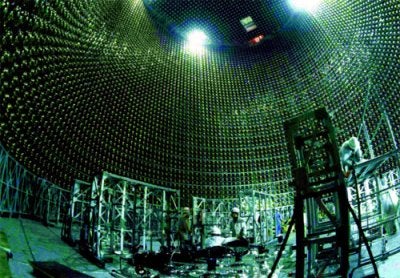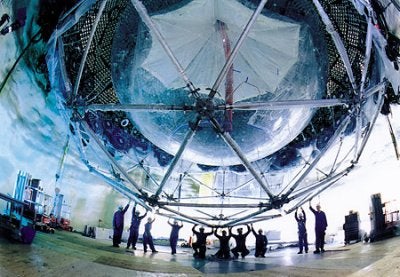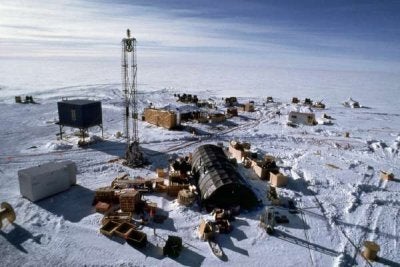Most neutrino detectors work by looking for a burst of Cerenkov (cherr-YENK-off) radiation as the signal that a neutrino has zinged through the instrument. Cerenkov radiation is an eerie, bluish light emitted when a particle travels through water (or any other transparent medium) at a velocity that’s faster than the speed of light in that medium. (Of course, the neutrino is still traveling slower than the speed of light in a vacuum, which remains the universal top speed, anywhere, anytime.)
Over the past few decades, dozens of experiments have joined the hunt for neutrinos. Astronomy.com has compiled a list of some of the largest neutrino detector experiments devised so far.
Homestake
Began operations: 1966
Location: Lead, South Dakota
Detection Method: neutrino-induced change of chlorine atoms into argon atoms
The Homestake experiment took a different approach than most neutrino detectors. It used a tank some 48 feet long and 20 feet in diameter located 4,850 feet underground and containing 100,000 gallons of perchloroethylene, a dry-cleaning fluid rich in chlorine. Neutrinos emitted by fusion reactions in the core of the sun changed chlorine atoms into argon ones, which the experimenters identified and counted.
Began operations: 1996
Location: Kamioka, Japan
Detection Method: Cerenkov flashes in water
The world’s largest neutrino detector is a cylindrical tank about 130 feet in diameter and in height. It consists of an inner volume and an outer volume which contains 32,000 tons and 18,000 tons of pure water, respectively. The outer detector is used to catch (and cancel) cosmic-ray muons that enter the detector. It also serves as a buffer to keep radiation emitted by the surrounding rock and walls from entering the inner volume. The inner detector has 11,200 photomultiplier tubes attached to the bottom, top, and sides facing inward. The tubes collect Cerenkov light. By measuring and precisely timing the direction and intensity of this light, scientists can derive information about neutrino interactions.
Began operations: 1999
Location: Sudbury, Ontario, Canada
Detection Method: Cerenkov flashes in water
The Sudbury Neutrino Observatory is a Cerenkov detector that uses 1,000 tons of heavy water as the medium. For shielding, the detector lies 6,800 feet underground in a former nickel mine. A 40-foot diameter acrylic vessel holds the heavy water and is surrounded by an array of 9,600 photomultiplier tubes mounted on a geodesic support structure. In September 2003, SNO scientists announced that adding two tons of table salt to the heavy water enabled them to measure solar neutrino much more precisely.
MiniBooNE
Began operations: 2002
Location: Fermi National Accelerator Laboratory, Batavia, Illinois
Detection Method: Cerenkov flashes in mineral oil
MiniBooNE is a forerunner and testbed for the Booster Neutrino Experiment, or BooNE. Its goal is to search for neutrino oscillations from muon neutrinos to electron neutrinos. The detector is a 40-foot-diameter, spherical tank containing 800 tons of mineral oil and 1,520 phototubes to sense Cerenkov flashes. The detector picks up one neutrino flash about every 20 seconds.
Began operations: 1997
Location: South Pole
Detection Method: Cerenkov flashes in clear polar ice
Rather than build a big tank to hold water or some other transparent medium, the team that built the Antarctic Muon and Neutrino Detector Array (AMANDA) drilled 19 deep holes in the Antarctic ice at the South Pole. The team then placed strings of phototubes in the holes to make a cylindrical array some 200 feet in diameter. The sensors lie 1 to 1.5 miles beneath the surface, a depth at which the ice is transparent and Cerenkov flashes are easily seen.
IceCube
Beginning of operations: TBA
Location: South Pole
Detection Method: Cerenkov flashes in clear polar ice
Scaling up from the AMANDA project, the IceCube neutrino detector is literally a gigantic ice cube. The project, under construction at the South Pole, will arrange nearly 5,000 photodetectors in 80 strings to form a cubical array one kilometer on a side.
You can find a detailed list of neutrino experiments, with links to their websites, at http://www.sno.phy.queensu.ca/sno/experiments.html.












